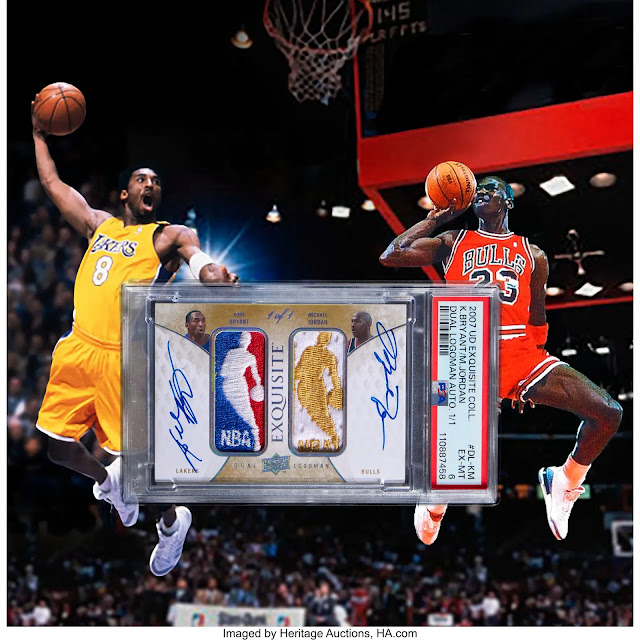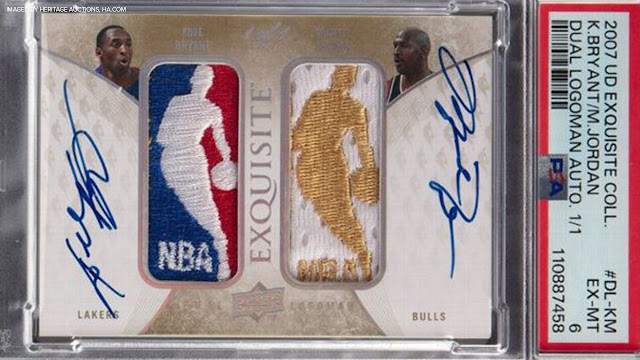On Saturday night, August 23, 2025, a rare, signed sports collectible card featuring NBA legends Michael Jordan and Kobe Bryant shattered records by selling for an astonishing $12.932 million at a Heritage Auctions event. The 2007-08 Upper Deck Exquisite Collection Dual Logoman Autographs Jordan & Bryant card, a one-of-a-kind item numbered 1-of-1, surpassed the previous record for the most expensive sports card, previously held by a 1952 Topps Mickey Mantle card that sold for $12.6 million in August 2022. This monumental sale not only cements the Jordan-Bryant card as the most expensive sports card ever sold but also ranks it as the second-most valuable sports collectible of all time, trailing only Babe Ruth’s 1932 World Series “called shot” jersey, which fetched $24.12 million nearly a year ago.
The sale, conducted by Heritage Auctions, has sent shockwaves through the sports memorabilia industry, highlighting the enduring allure of Michael Jordan and Kobe Bryant, two of basketball’s greatest icons. The transaction also underscores the growing sophistication and financial stakes of the collectibles market, which has evolved from a niche hobby to a multi-billion-dollar industry. With the buyer’s identity remaining undisclosed, the sale has sparked widespread discussion about the value of rare sports memorabilia, the impact of authentication, and the cultural significance of Jordan and Bryant’s legacies. This article delves into the details of the sale, the history of the card, its place in the broader collectibles market, and the broader implications for the industry.
The Record-Breaking Card: A Unique Treasure
The 2007-08 Upper Deck Exquisite Collection Dual Logoman Autographs Jordan & Bryant card is a singular artifact in the world of sports collectibles. Numbered 1-of-1, it is the only card of its kind, featuring autographs from both Michael Jordan and Kobe Bryant, alongside patches from their respective NBA jerseys. The “Logoman” designation refers to the inclusion of these jersey patches, which are cut from the iconic NBA logo on the players’ uniforms, adding an unparalleled level of rarity and authenticity to the card. The combination of two of basketball’s greatest players, their signatures, and the unique jersey patches makes this card a holy grail for collectors.
Chris Ivy, Heritage Auctions’ director of sports auctions, provided insight into the card’s significance, recalling the origins of the Upper Deck Exquisite Collection. Launched in the 2003-04 season, the Exquisite Collection was a groundbreaking release that redefined the sports card market. Priced at $500 for a five-card pack, the set was initially met with skepticism, with some collectors mocking Upper Deck for its high cost. However, the collection’s focus on premium, high-quality cards—featuring autographs, jersey patches, and limited-edition items—tapped into a growing demographic of serious collectors who valued rarity and exclusivity over mass-produced cards.
“They were kind of mocked, but it tapped into a demographic that wasn’t interested in gimmicks: They just wanted the best of the best,” Ivy explained. “They were adding patches and signatures, Logomen – this was [one of] the first times logos from the jersey were used in this manner.” The Exquisite Collection’s innovative approach paid dividends, producing iconic cards like a $5.2 million LeBron James rookie card, which held the record for the most expensive basketball card until the Jordan-Bryant sale. The Jordan-Bryant card, released in the 2007-08 set, represents the pinnacle of this premium approach, combining the star power of two NBA legends with unmatched rarity.
The Auction: A Bidding War for History
The sale of the Jordan-Bryant card was the culmination of a carefully orchestrated process that began in February 2025, when the card’s previous owner decided to consign it to Heritage Auctions. The owner, who had held the card for over a decade, had previously turned down private offers in the “high seven-figure” range, opting instead for a public auction to maximize its value. “The pre-auction estimate was $6 million-plus, so sometimes if a piece is unique like this, it’s really beneficial to let it have its day,” Ivy said. “[Where] you can have new collectors come out of the woodwork or people willing to participate and pay more.”
The decision to go to auction proved prescient, as the card attracted intense interest from collectors worldwide. The bidding war drove the final sale price to $12.932 million, nearly doubling the pre-auction estimate and surpassing the previous record set by the 1952 Topps Mickey Mantle card. The anonymous buyer, whose identity remains undisclosed, secured a piece of sports history, joining an elite group of collectors who own the most valuable memorabilia in the world.
The card’s condition, graded a 6 out of 10 by Professional Sports Authenticator (PSA), was a point of discussion in the lead-up to the auction. In the collectibles market, grading significantly impacts a card’s value, with higher grades typically commanding higher prices. Ivy noted that a 1986 Fleer Michael Jordan card in PSA 6 condition sells for a couple thousand dollars, while a PSA 10 can fetch nearly $200,000. However, the Jordan-Bryant card’s 1-of-1 status mitigated the impact of its relatively modest grade. “Grades matter as far as pricing goes for standard-issue cards, but this is a 1-of-1, so the grade is less important overall to how the card performed,” Ivy explained. The card’s rarity, combined with the star power of Jordan and Bryant, drove its value far beyond what its grade might suggest.
The Authenticity Factor: Addressing Industry Concerns
The sale comes at a time when the sports memorabilia industry is grappling with concerns about authenticity, particularly in light of the ongoing Brett Lemieux fraudulent memorabilia scandal. Lemieux, a former dealer, was implicated in a scheme involving counterfeit items, shaking the confidence of some collectors. Against this backdrop, Chris Ivy emphasized the impeccable provenance of the Jordan-Bryant card, reassuring collectors of its legitimacy.
“[The scandal] makes items like this a little more desirable: Upper Deck has Jordan under contract; he’s been with them for decades. Kobe was with Upper Deck until 2009,” Ivy said. “They worked with these athletes directly to have this item signed. It’s guaranteed by them as well as PSA. That’s why you see a premium for items that have verified provenance and authentication.” The direct involvement of Upper Deck, a trusted name in the industry, and the authentication by PSA, a leading grading authority, provided collectors with confidence in the card’s authenticity, contributing to its record-breaking price.
The emphasis on provenance reflects a broader trend in the collectibles market, where buyers are increasingly prioritizing items with verifiable histories. The Jordan-Bryant card’s connection to Upper Deck, combined with the autographs and jersey patches directly sourced from the players, makes it a gold standard for authenticity. This level of trust is critical in an industry where high-value transactions are scrutinized, and it underscores why the card commanded such a premium.
The Jordan and Bryant Legacy
The sale of the Jordan-Bryant card is a testament to the enduring legacies of Michael Jordan and Kobe Bryant, two of the most iconic figures in basketball history. Michael Jordan, widely regarded as the greatest basketball player of all time, redefined the sport during his career with the Chicago Bulls, winning six NBA championships, five MVP awards, and countless accolades. His global influence, amplified by his Air Jordan brand and media presence, has made him a cultural icon whose memorabilia continues to command astronomical prices.
Kobe Bryant, who tragically passed away in a helicopter crash in January 2020, was a worthy successor to Jordan’s legacy. A five-time NBA champion with the Los Angeles Lakers, Bryant was known for his relentless work ethic, clutch performances, and “Mamba Mentality.” His untimely death at the age of 41 only heightened the value of his memorabilia, as collectors sought to preserve his legacy. The fact that the Jordan-Bryant card sold on what would have been Bryant’s 47th birthday added an emotional resonance to the transaction, further fueling interest in the auction.
The card’s dual autographs and jersey patches symbolize the connection between these two legends, who shared a mutual respect and competitive spirit. Jordan mentored Bryant early in his career, and their on-court battles, particularly in the late 1990s and early 2000s, are the stuff of NBA legend. The card captures this unique relationship, making it a cultural artifact as much as a collectible item. Its sale for $12.932 million reflects not only the rarity of the card but also the enduring appeal of Jordan and Bryant as transcendent figures in sports history.
The Surge in Kobe Bryant Memorabilia
The Jordan-Bryant card sale is part of a broader surge in high-value transactions involving Kobe Bryant memorabilia. In recent months, collectors have shown a renewed interest in Bryant’s items, driven by nostalgia, his tragic passing, and the growing value of rare basketball cards. High-end collector Matt Allen, known as Shyne on social media, recently made headlines by spending $4 million on two 1-of-1 Bryant Panini Flawless Logoman cards. The first, from the 2017-18 set, sold for $1.7 million, while the second, from the 2015-16 set, fetched $2.3 million, setting the previous record for a Bryant card until the Jordan-Bryant sale eclipsed it.
Allen’s purchases highlight the premium placed on Bryant’s memorabilia, particularly items featuring his autograph and jersey patches. The Panini Flawless Logoman cards, like the Upper Deck Exquisite Collection card, are prized for their rarity and direct connection to the player. The surge in Bryant’s memorabilia value also reflects the emotional connection fans and collectors feel toward him, as his legacy continues to inspire new generations. The timing of the Jordan-Bryant card sale on Bryant’s birthday added a poignant layer to the transaction, with collectors and fans reflecting on what might have been had Bryant lived to see his 47th year.
The Evolution of the Sports Collectibles Market
The $12.932 million sale of the Jordan-Bryant card is a milestone in the evolution of the sports collectibles market, which has grown exponentially in recent years. Once a niche hobby for enthusiasts, sports card collecting has become a mainstream investment vehicle, attracting high-net-worth individuals, hedge funds, and even institutional investors. The market’s growth has been fueled by several factors, including the rise of digital platforms like eBay and Goldin Auctions, the influence of social media in showcasing rare items, and the increasing scarcity of high-quality, vintage cards.
The Upper Deck Exquisite Collection, introduced in 2003-04, played a pivotal role in this transformation. By focusing on premium, limited-edition cards with autographs and memorabilia, Upper Deck tapped into a demand for exclusivity that resonated with collectors. The success of the Exquisite Collection paved the way for other premium sets, such as Panini Flawless and Topps Chrome, which have produced some of the most valuable cards in history. The $5.2 million sale of a LeBron James rookie card from the Exquisite Collection in 2021 was a landmark moment, and the Jordan-Bryant card’s record-breaking sale further solidifies the set’s legacy.
The market’s growth has also been driven by the increasing crossover between sports and pop culture. Athletes like Michael Jordan and Kobe Bryant are not just sports figures but global icons whose influence extends to fashion, entertainment, and branding. The Air Jordan sneaker line, for example, has become a cultural phenomenon, with rare pairs selling for hundreds of thousands of dollars. Similarly, Bryant’s Oscar-winning short film Dear Basketball and his post-retirement ventures in media and philanthropy have added to his mystique, making his memorabilia highly sought after.
The Impact of the Lemieux Scandal
The Brett Lemieux scandal, which involved the sale of counterfeit memorabilia, has cast a shadow over the collectibles industry, making the authenticity of the Jordan-Bryant card a critical factor in its value. The scandal, which surfaced in recent years, exposed vulnerabilities in the market, as fraudulent items undermined collector confidence. In response, auction houses like Heritage and grading companies like PSA have doubled down on authentication processes, emphasizing the importance of provenance.
The Jordan-Bryant card’s direct connection to Upper Deck, combined with PSA’s authentication, made it a safe investment for collectors wary of fraud. Upper Deck’s long-standing relationships with Jordan and Bryant, who signed the card during their respective contracts with the company, provided an additional layer of credibility. Ivy’s comments about the card’s guaranteed authenticity underscore the premium placed on items with verifiable histories, particularly in the wake of scandals that have shaken the industry.
The Broader Implications
The sale of the Jordan-Bryant card has far-reaching implications for the sports collectibles market and beyond. First, it reinforces the market’s status as a legitimate investment class, with high-value items like the Jordan-Bryant card rivaling fine art and luxury goods in terms of financial returns. The $12.932 million price tag places the card in the same league as iconic artworks and historical artifacts, highlighting the growing mainstream acceptance of sports memorabilia.
Second, the sale underscores the enduring appeal of Michael Jordan and Kobe Bryant, whose legacies continue to resonate with collectors and fans. Jordan’s global brand, built on his on-court dominance and off-court ventures, remains unmatched, while Bryant’s tragic passing has amplified the emotional and financial value of his memorabilia. The card’s dual autographs and jersey patches capture a moment in time when two basketball titans were linked, making it a cultural artifact as much as a collectible.
Third, the sale highlights the importance of rarity and exclusivity in driving value. The 1-of-1 status of the Jordan-Bryant card, combined with its unique features, set it apart from even the most valuable standard-issue cards. This trend toward premium, limited-edition items is likely to continue, as collectors seek out one-of-a-kind pieces that offer both financial and emotional rewards.
Finally, the sale serves as a reminder of the challenges facing the collectibles market, particularly in terms of authenticity and market stability. The Lemieux scandal has underscored the need for robust authentication processes and transparency, while the high prices of top-tier items raise questions about the sustainability of the market’s growth. As more investors enter the space, the industry will need to balance accessibility with exclusivity to maintain its appeal.
The Future of Sports Collectibles
Looking ahead, the Jordan-Bryant card sale is likely to inspire further growth in the sports collectibles market. Auction houses, grading companies, and manufacturers like Upper Deck and Panini will continue to innovate, creating new products that cater to the demand for rare, high-value items. The rise of digital collectibles, such as NFTs, and blockchain technology could also play a role in ensuring authenticity and transparency, addressing concerns raised by scandals like Lemieux’s.
For collectors, the sale is a call to action to seek out unique, authenticated items with strong provenance. The success of the Jordan-Bryant card demonstrates that the right combination of rarity, star power, and authenticity can yield extraordinary returns. However, it also underscores the importance of due diligence, as collectors must navigate a market fraught with risks.
For fans, the sale is a celebration of the legacies of Michael Jordan and Kobe Bryant, whose contributions to basketball and popular culture continue to inspire. The card’s record-breaking price is a testament to their enduring impact, reminding us of the power of sports to unite and captivate audiences worldwide.
Conclusion: A Landmark Moment
The $12.932 million sale of the 2007-08 Upper Deck Exquisite Collection Dual Logoman Autographs Jordan & Bryant card is a landmark moment in the history of sports collectibles. By setting a new record for the most expensive sports card ever sold, it underscores the growing financial and cultural significance of the collectibles market. The card’s rarity, authenticity, and connection to two of basketball’s greatest legends—Michael Jordan and Kobe Bryant—make it a singular artifact that captures a moment in time.
As the sports memorabilia industry continues to evolve, the Jordan-Bryant card will stand as a benchmark for what is possible when rarity, star power, and authenticity converge. Its sale on what would have been Kobe Bryant’s 47th birthday adds an emotional layer to the transaction, reminding us of the enduring legacies of these two icons. For collectors, investors, and fans, the sale is a moment to celebrate the past, reflect on the present, and look forward to the future of a market that continues to captivate and inspire.







